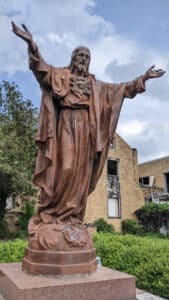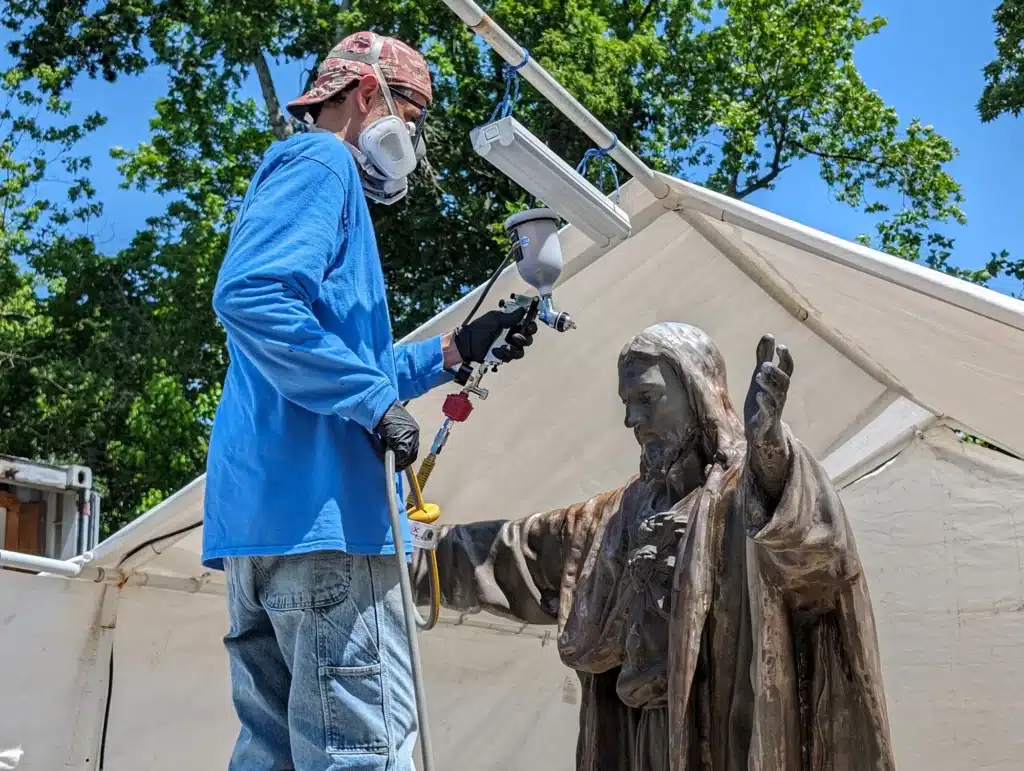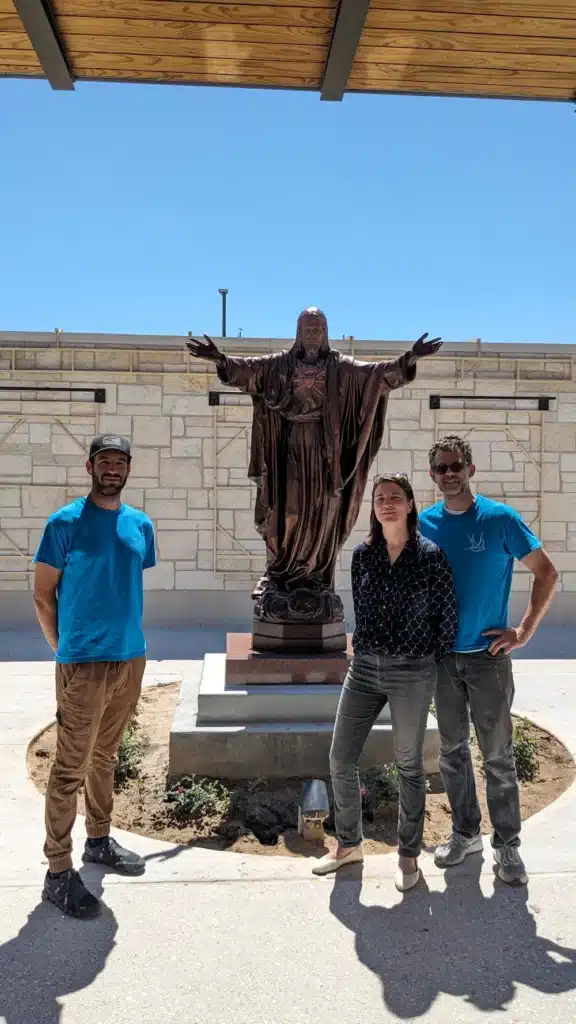Religious statue restoration
The restoration of a religious statue in downtown Houston, Texas started with undoing previous restoration work, followed by its repainting with a finish that matched the original bronze effect. Sculpture conservators OnAim tell the story.
The Sacred Heart of Jesus Blessing statue, measuring 84¨ x 42¨ (2.1m x 1.1m), depicts Jesus with arms extended in a welcoming posture, one knee slightly bent. His robe is draped around his body, open around the front, revealing the sacred heart on his chest.
The statue graced the front of the old Downtown Houston Co-Cathedral of the Sacred Heart church for many years. It was one of the pieces saved to now welcome the community at the new Archbishop Fiorenza Plaza, located at the corner of St. Joseph and San Jacinto, directly across from the entrance to the Co-Cathedral of the Sacred Heart.

The Sacred Heart of Jesus Blessing statue before restoration
This statue, confirmed through material analysis to be made of zinc, was manufactured by the Daprato Statuary Company based in Chicago-New York, using its Orbronze technique. A page from Daprato’s 1929 trade catalogue indicates that Orbronze is a combination of superior metals, having a highly perfected copper surface, oxidised and finished in fine bronze effect.
Historical context
Zinc statues became popular in the 1850s as a more affordable alternative to bronze. They were widely distributed, especially to small towns, through trade catalogues and then delivered by train. The use of the material diminished though, and by the 1950s zinc statues were no longer produced. Thus these statues are historically significant, reflecting early 20th-century American life.
Despite its previous popularity, there are many downsides to the metal – especially that it is a weak and brittle material. Many of the historical statues experience cracking at the joints as they start leaning from the weight and lack of internal structure. It used to be common practice to treat these statues by filling them with concrete, which created more problems by allowing water to penetrate and further damaging the metal.
Houston’s Sacred Heart of Jesus statue most likely experienced some brittleness when it suffered severe damage during a vandalism incident in 1996. A pipe was used to knock off its head and hands. This caused extensive fracturing and breakage to the right hand, arm, shoulder and chest area as well as damage to the head. It became apparent that the chest area to the right of the sacred heart where the cloth drapes over was damaged so severely as to cause a total loss of metal in that section.
The previous restoration was done with a concrete fill surrounding a mild steel armature, secured in various spots with stainless steel screws/bolts, and cracks/seams filled with a putty-type epoxy. The missing sections were carved out of concrete. The statue was painted at least three times previously, with the first of these coats being copper-based in nature.
Restoration process
Paint removal and cleaning: The restoration began by stripping the paint and finish. This revealed the original bronze-like finish and the concrete inside the statue. Soldering material was softened with heat to allow parts of the statue to be taken apart.
Interior cleaning: As pieces came apart, the interior concrete, plaster and polyester filler was removed using power tools. In preparation for media blasting, all pieces of the statue were heat- washed to remove any remaining solder material.
Surface preparation: The statue pieces were blasted with fine glass beads to clean off any remaining oxidation and old repairs. This exposed the true extent of the damage – a lot of pitting had occurred where the metal was in direct contact with the concrete.
Structural reinforcement: The statue’s base was attached to its granite pedestal using a sturdy stainless-steel frame and brass spacers to help with moisture evaporation. Inside, brass strips were used to reinforce the structure. In areas where soldering was not possible, a strong epoxy putty, Belzona 1111, was used to fill cracks, sometimes backed with brass screws for extra support. Belzona is a two-part repair composite for metal repair and resurfacing based on solvent-free epoxy resin reinforced with silicon steel alloy. This repair material will not corrode and resists a wide range of chemicals.
Right shoulder reconstruction: The right shoulder, badly damaged and previously reshaped with concrete, was recast using a mould made from latex and fibreglass. This new resin piece was attached with Belzona and brass tabs, and then painted to blend in with the rest of the statue.
Final painting: For the final coating of the sculpture, OnAim used Permalac NT paint, which is a fast-drying, easy-to-apply acrylic lacquer coating. It is a transparent tinted, low VOC formula which lays down similar to paint. Permalac NT Bronze is highly resistant to environmental breakdown caused by UV, acid rain and salt. OnAim applied a darker bronze-coloured basecoat which was then highlighted with a lighter copper-coloured topcoat, most closely matching the original Orbronze patina. It was finished off with three coats of Permalac NT semi-gloss clear.

OnAim repainting the sculpture with Permalac NT
Restoration findings and historical insights
During the restoration, the number 31 was found stamped inside many metal sections, possibly indicating the edition number. This suggests the statue might be from a 1931 mould, differing slightly from a similar statue in a 1929 catalogue. Existing repairs showed the use of copper plates for filling holes, aligning with original techniques, and the added brass tabs and screws were consistent with these methods.
The restoration of the Sacred Heart of Jesus Blessing statue not only preserved its physical structure but also honoured its historical and cultural significance, ensuring it remains a cherished artefact for future generations.
Read more articles like this in the latest issue of Protective Coatings Expert

The Sacred Heart of Jesus Blessing statue after restoration had been completed by OnAim Conservation

